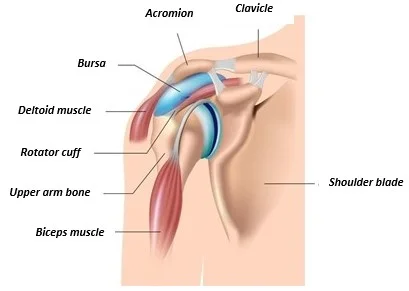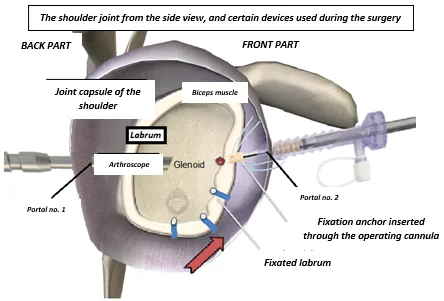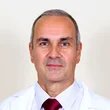This is how our application simplifies the booking and administration process. Interested >>
Shoulder joint stabilization – Bankart procedure, Latarjet procedure
What is the labrum capsule ligament complex? The structure of the shoulder joint.
The shoulder joint consists of the head of the upper arm bone, the joint surface of the shoulder blade, and the capsule and ligaments of the joint. The socket of the joint is smaller than the head of the adjusting upper arm bone due to anatomical causes. To maintain the stability of the joint in every phase of the movement, a fibrocartilaginous ring is located around the socket, which is called labrum (glenoid labrum). The capsule and the stabilizing ligaments form an organic unit with this fibrocartilaginous ring.

General information about shoulder joint instability
A labrum injury results in the instability of the adjusting head, which could slide out of the socket causing instability, pain, and additional damages. In more severe cases, this could cause the complete dislocation, the luxation of the shoulder joint. Injuries may affect the fibrocartilaginous ring in various spots, and its consequences vary. The most common consequence is the injury of the front lower part, which is called the Bankart lesion. This part of the fibrocartilaginous ring is the most susceptible to injuries, but various impacts may cause a rupture in other parts too. In case of a shoulder joint dislocation, the ligaments, cartilages, and the joint capsule get injured in the second of the first dislocation, and they may detach from the bony rim of the socket. A huge force impact may also fracture the bony part of the socket. In case of a complete dislocation, a depression may develop on the upper arm bone’s head, which is called the Hill Sachs lesion. Extreme force impacts (falling on an extended arm, direct impact on the shoulder joint, a sudden pulling force e.g., when lifting a heavy load), or repeated smaller loads (throwing athletes, racket sports, weightlifting) play a role in the development of the injuries. Anatomical variations may increase the frequency of these.
Multiple dislocations may also cause that the front part of the joint socket is smoothened. This may contribute to the episodes of instability becoming more frequent.
Multidirectional instability may occur as well, which may be often caused by generalized joint laxity, or connective tissue diseases.
Which are the potential symptoms?
The symptoms are very similar to other shoulder injuries:
- Pain produces in the range of motion above the head, especially during outward rotation (throwing movement).
- Obstruction, clicking, bumping, slipping.
- Feeling of instability.
The joint may dislocate in case of joint instability. The frontal dislocation of the upper arm bone typically happens when the arm is rotated outward while being lifted to the front, while the back dislocation most commonly happens when the arm is rotated inward while being lifted up forward. A multidirectional instability may be caused by generalized joint laxity, and muscle weakness too. Pain, numbness, and sensory disturbances of the upper limb may develop as a consequence of the dislocation.
What are the treatment options?
Basically, there are two types of treatment options available. Non surgical (conservative) and surgical therapy.
The goals of the conservative treatment
The main goals of the treatments are to achieve a painless condition, restore the upper arm’s range of motion, strengthen the stabilizing musculature and the reflex arc. After the first dislocation, even a painless, loadable, stable shoulder can be achieved following conservative treatment, depending on the age. However, we recommend surgical treatment in case of repeated dislocations, and instability symptoms.
The methods of conservative treatment
Initial pharmacological treatment, which consists of using painkillers and anti inflammatory drugs, and various physical therapeutic treatments can be considered as well. However, the most important is physiotherapy and within that, improving the muscle innervations and the spatial awareness of the joints (PNF). Strengthening the muscles of the shoulder girdle additionally plays an important role in restoring the stability.
Surgical treatment
The goal of the surgical treatment is to restore shoulder stability, which can be achieved by various surgical solutions. The point of the surgery described later is that the ruptured fibrocartilaginous ring (labrum) is secured to its natural location, so to the rim of the socket with anchors, which were designed specifically for this purpose. We try to restore the natural anatomy with this procedure. The intervention is usually performed by an arthroscopic method (a method using an endoscope, camera) through two holes (portals): one in the front and one the back of the shoulder. This method minimizes the pain after surgery, since muscles, tendons, and other tissues are not cut. Sometimes the surgery can only be performed by using an open technique if a bony injury happened too. In cases like this, creating a bony bumper may become necessary too (Latarjet procedure).
Sometimes it could also happen that the labrum injured to such an extent that it cannot be secured in its anatomical position, so the type of the surgery must be switched for this reason too. In this case, the capsule is narrowed, duplicated, or the above mentioned bony bumper is created for the purpose of stabilizing the shoulder joint. This happens with the awareness and the consent of the patient during a different surgery, if necessary.
What happens during shoulder surgery?
- Usually, the surgery is performed in general anesthesia (narcosis). The anesthesiologist informs the patient about the characteristics of the anesthesia.
- After anesthesia is induced, your body is positioned on the surgical table, so that you are in an optimal position for the surgery. Usually, this is performed while lying on the healthy shoulder’s side. In order to have enough space within the shoulder joint for the intervention, a certain amount of pulling is necessary. This means that the upper arm bone’s head moves away from the socket. This is achieved by securing your arm to a frame that is assembled to the surgical table; this helps in the careful pulling and moving it away from the body.
- Shaving the surgical site, if necessary.
- The skin of the surgical site and its area is washed multiple times with an antiseptic liquid.
- You will be covered with sterile sheets, only the surgical site is left uncovered (isolation).
- Arthroscopic shoulder joint reconstruction is routinely performed following standard preparation from the back side of the shoulder through a smaller hole (portal) by diagnostic arthroscopy (an examination with a camera, endoscopy).
- Following this, another incision point is made on the front part of the shoulder joint. The anchors are placed on the rim of the socket through this portal. The labrum will be positioned between the two stems of the surgical thread, which is located on the anchor, and a sliding knot will be put on it.
- In case of an open surgery, an incision of 5 8 cm is made on the front part of the shoulder joint. In this case, the anchors, stitches, and ties are placed through this exploration.
- This secures eventually the fibrocartilaginous ring to the anchor on the rim of the socket. The anatomical reconstruction can be provided this way. Usually, 2 3 anchors are necessary for secure fixation.
- The surgical area is washed after the intervention, then the camera, and the cannulated operating portal, which provides the width of the portal on the contralateral side, are removed. The thickness of the latter requires that the skin is unified with a stitch.
- In case of the Latarjet procedure, the coracoid process, which is located next to the shoulder joint, is detached, and it is screwed to the front part of the socket after rotating it. This will later make up for the smoothened, missing bony parts, and inhibit the forward movement of the upper arm bone.
- The patient’s arm will be secured to the body with net bandage at the end of the surgery.

What happens if the justified surgical treatment is not performed?
- The unstable shoulder joint will be prone for additional dislocations causing further damages in its area.
- The pain may persist or increase.
- The movement of the upper arm may be limited further.
- The quality of life may deteriorate.
- A surgery performed later may become more difficult technically, and its effectiveness may decrease.
If you have any questions, please send a letter to magankorhaz@bhc.hu!



